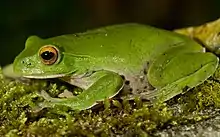Zhangixalus moltrechti
Zhangixalus moltrechti is a species of frog in the family Rhacophoridae. It is endemic to Taiwan, where it has a wide distribution in hilly areas.[1][2] Common names Moltrecht's green treefrog, Moltrecht's treefrog, Taiwan treefrog, and Nantou flying frog have been coined for it.[2]
| Zhangixalus moltrechti | |
|---|---|
 | |
| Scientific classification | |
| Domain: | Eukaryota |
| Kingdom: | Animalia |
| Phylum: | Chordata |
| Class: | Amphibia |
| Order: | Anura |
| Family: | Rhacophoridae |
| Genus: | Zhangixalus |
| Species: | Z. moltrechti |
| Binomial name | |
| Zhangixalus moltrechti (Boulenger, 1908) | |
| Synonyms[2] | |
| |
Etymology
The specific name moltrechti honors Arnold Moltrecht, a Latvian entomologist, lepidopterist, and ophthalmologist; while stationed in Vladivostok he also traveled and collected in Taiwan.[3]
Description
Zhangixalus moltrechti is a medium-sized tree frog, females are 5–6 cm (2.0–2.4 in) in snout-vent length; males are slightly smaller,[4] 3.6–4.2 cm (1.4–1.7 in).[5] The finger and toe tips have well-developed discs. Skin is smooth. The overall coloration is green; some individuals have few white spots. The belly is white yellow. The hidden surfaces of the hind legs are red or orange with black spots. The iris is orange red.[4]
Habitat and conservation
Zhangixalus moltrechti occurs in forests, orchards, and tea plantations[1] at elevations below 3,000 m (9,800 ft).[4] Breeding takes place in bodies of standing water, such as ponds, pools, cisterns, and blocked roadside ditches.[1][6] It may also breed in pools of intermittent streams, potholes, and streamside pools.[1] High-elevation (~2,000 m (6,600 ft)) populations breed in spring and summer (April–September), whereas low-elevation (<500 m (1,600 ft)) populations breed in late autumn to early spring (October–March); mid-elevation populations breed throughout the year, with peak in spring. The eggs are laid in foam nests above the water, attached to branches of trees, bushes, or walls.[6]
Zhangixalus moltrechti is a common and adaptable species that is not facing significant threats. It occurs in several protected areas.[1]
References
- Lue Kuangyang, Chou Wenhao (2004). "Zhangixalus moltrechti". IUCN Red List of Threatened Species. 2004: e.T59005A11866212. doi:10.2305/IUCN.UK.2004.RLTS.T59005A11866212.en. Retrieved 17 November 2021.
- Frost, Darrel R. (2018). "Rhacophorus moltrechti Boulenger, 1908". Amphibian Species of the World: an Online Reference. Version 6.0. American Museum of Natural History. Retrieved 5 October 2018.
- Beolens, Bo; Watkins, Michael & Grayson, Michael (2013). The Eponym Dictionary of Amphibians. Pelagic Publishing. p. 146. ISBN 978-1-907807-42-8.
- Lue, Kuang-Yang (2011). "Rhacophorus moltrechti". BiotaTaiwanica. Archived from the original on 4 March 2016. Retrieved 16 August 2012.
- Lue, Kuang-Yang; Lai, June-Shiang & Chen, Szu-Lung (1994). "A new species of Rhacophorus (Anura: Rhacophoridae) from Taiwan". Herpetologica. 50 (3): 303–308. JSTOR 3892703.
- Chang, Y.-M.; Tseng, W.-H.; Chen, C.-C.; Huang, C.-H.; Chen, Y.-F. & Hatch, K. A. (2014). "Winter breeding and high tadpole densities may benefit the growth and development of tadpoles in a subtropical lowland treefrog". Journal of Zoology. 294 (3): 154–160. doi:10.1111/jzo.12162.
